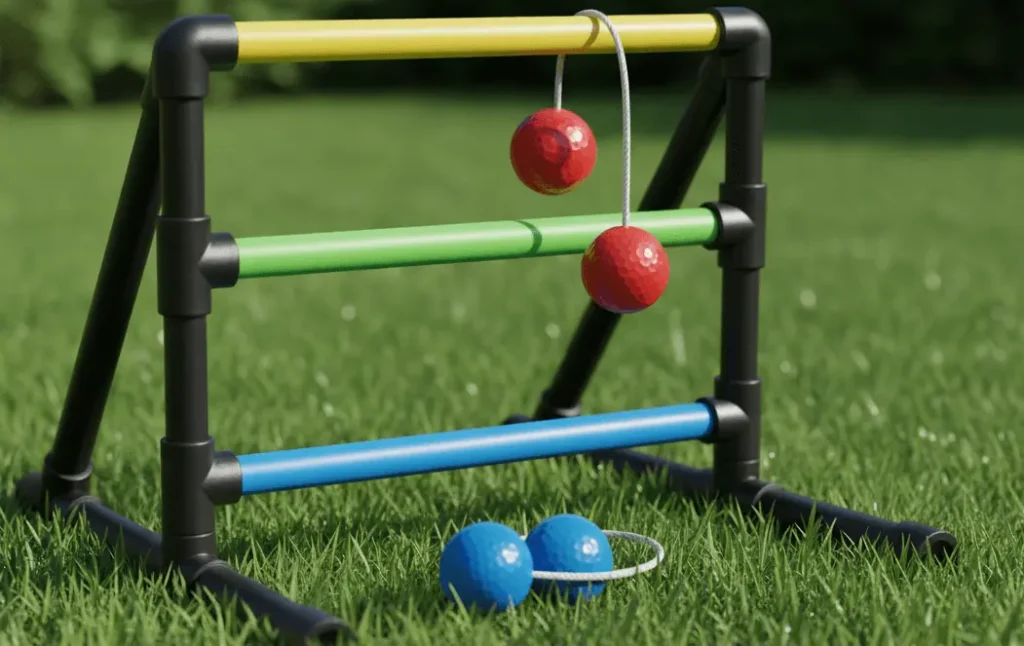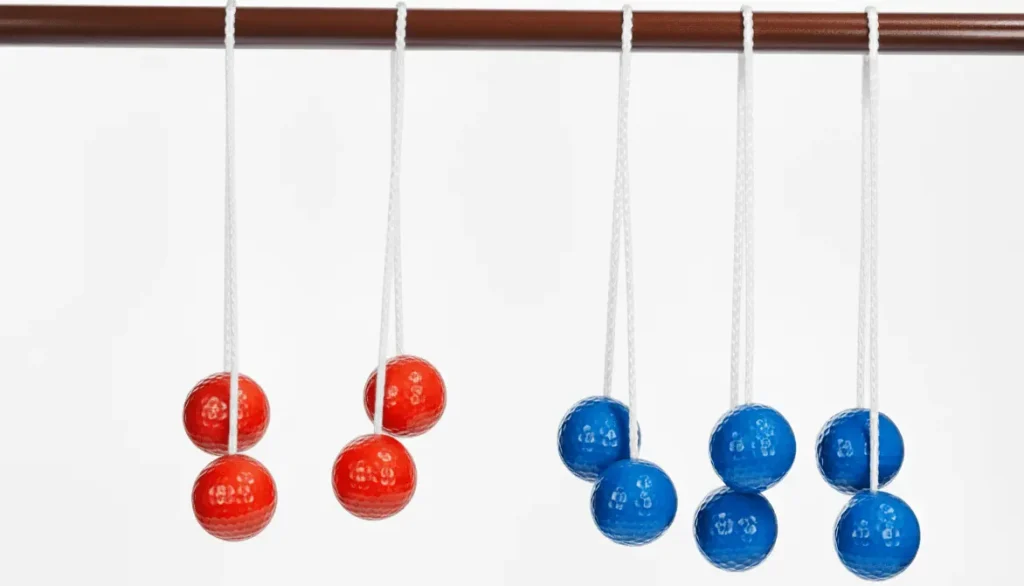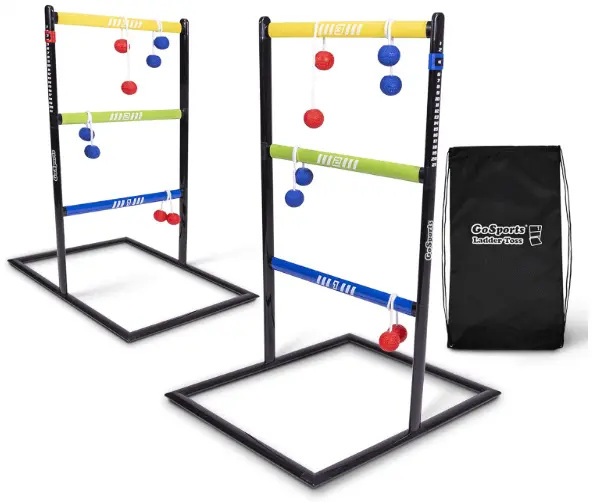How to Play Ladder Ball | Ladder Ball Game Rules
You toss golf balls tied together with string at a ladder. The balls wrap around the rungs. You score points. Simple game. Huge fun.
Ladder ball goes by many names. Ladder toss. Ladder golf. Hillbilly golf. Bolo toss. Whatever you call it, this backyard game brings people together at tailgates, cookouts, and beach parties.
You don’t need athletic skills. Just decent aim and a competitive spirit.
Let me show you how to play.
What You Need for Ladder Ball
Ladder ball equipment is straightforward.
You need two ladder structures. Each ladder has three horizontal rungs mounted on a vertical frame. The rungs sit 13 inches apart from each other. Most ladders use PVC pipe or wood construction.
You need six bolas. A bola is two golf balls connected by a nylon rope. The balls sit 13 inches apart on the rope. You get three bolas in one color and three in another color. Common colors are red and blue, or yellow and blue.
That’s everything. Most ladder ball sets include both ladders and all six bolas in one package. You can find complete sets at sporting goods stores or online.
Grab this ladder ball set to set up your game quickly. It includes everything you need to play.
Setting Up Your Ladder Ball Court
Place your ladders 15 feet apart. Measure from the base of one ladder to the base of the other. Don’t measure from the extended legs.
If you don’t have a measuring tape, walk five paces between the ladders. This works fine for casual games and gives you a slightly shorter distance for kids.
Set both ladders on level ground. Grass, sand, concrete, or dirt all work. The ladders need to stand stable without tipping over.
Your playing area is ready.
How Many Players Can Play Ladder Ball
Ladder ball accommodates two to four players.
One versus one: Two players compete directly. You stand at opposite ladders. Toss your bolas at the ladder across from you. After both players throw, walk to the other end and throw back.
Two versus two: Four players form two teams. Teammates stand at opposite ladders, each next to an opponent. One team uses one bola color, the other team uses the second color. You throw across to your teammate’s ladder.
Teams of two create the most popular format. Standing next to your opponent adds friendly competition and banter.
Basic Ladder Ball Rules
The rules are simple enough to explain in two minutes.
- Score exactly 21 points to win. Going over 21 means your points for that round don’t count.
- Throw all three bolas per turn. Each player tosses their three bolas one at a time. After you throw all three, the next player goes.
- Throw underhand. No overhand throws allowed. Underhand gives you better control anyway.
- Toss individually. Throw one bola at a time. You cannot throw multiple bolas together.
- Stay behind your ladder. The ladder marks your throwing line. Don’t step in front of it when tossing.
- Bounces count. Your bola can bounce off the ground before catching on a rung. As long as it ends up hanging, you score.
- Knock offs are legal. If your bola knocks an opponent’s bola off the ladder, their bola doesn’t score. This defensive strategy is encouraged.
- Score after everyone throws. Wait until all players have thrown their three bolas before counting points.
Ladder Ball Scoring System
Points are awarded based on which rung your bola hangs from at the end of the round.
Only bolas still hanging on the ladder when the round ends count toward your score. If your bola got knocked off during play, it scores zero points.
Count all your bolas on the ladder. If you have one bola on the top rung, one on the middle, and one on the bottom, you score 6 points for that round (3 + 2 + 1).

Bonus Points
Some players use optional bonus scoring.
Same rung bonus: Get all three of your bolas on the same rung and earn 1 bonus point. Three bolas on the top rung would score 10 points total (3 + 3 + 3 + 1 bonus).
Ladder bonus: Get one bola on each of the three rungs in the same round and earn 1 bonus point. This scores 7 points total (3 + 2 + 1 + 1 bonus).
These bonuses are optional. Agree on whether you’re using them before starting.
How to Win at Ladder Ball
Victory requires hitting exactly 21 points.
Keep a running total of your points after each round. First player or team to reach exactly 21 wins immediately.
The exact point requirement creates strategy. If you have 19 points, you need exactly 2 points to win. Landing one bola on the middle rung wins the game. Landing one on the top rung gives you 22 points, which busts you.
When you go over 21 points in a round, those points don’t count at all. You start the next round with the same score you had before. If you had 18 points and score 5 in a round, you bust. You still have 18 points going into the next round.
Winning by Two in Overtime
Regular gameplay has no margin requirement. You can win 21 to 20, 21 to 15, or 21 to 0.
If both players or teams reach 21 points in the same round, the game goes to overtime. Play continues with additional rounds until one side ends a complete round with a lead of 2 or more points.
The two point rule only applies during overtime.
Starting the Game and Turn Order
Flip a coin to decide who throws first. The winner of the coin toss chooses whether to go first or second.
Player one throws all three bolas, one at a time. Then player two throws all three bolas. This completes one round.
Score the round based on where bolas landed. The player or team with the most points in that round throws first in the next round. If neither side scores, the same player who went first throws first again.
Continue alternating based on who won the previous round.
Throwing Techniques for Ladder Ball

No official rules dictate exactly how you must throw, but underhand works best.
Hold the bola by the rope between your middle and index fingers. Let the golf balls dangle below your hand. Swing your arm back and forward like a pendulum. Release as your arm comes forward.
The key is creating a good pendulum motion. This spreads the two golf balls apart during flight. A wider spread gives you better odds of catching a rung.
Some players add a wrist flick at the release point. This adds spin and control.
Experiment with grip positions. Holding closer to one ball versus holding at the rope’s center changes the bola’s flight pattern.
Practice your aim. Focus on a specific rung rather than just throwing at the whole ladder.
Defensive Throwing Strategy
Knocking off opponent bolas is legal and smart.
If your opponent has bolas on high value rungs, aim to hit them off. A well placed throw that removes their 3 point bola and lands your 1 point bola gives you a 4 point swing.
Some players intentionally bounce their bola off the ground to come up at an angle. This technique can dislodge hanging bolas more effectively.
Balance offense and defense. Sometimes securing your own points matters more than disrupting theirs.
Ladder Ball Etiquette and Gamesmanship
Ladder ball encourages friendly distraction.
Making comments, sounds, or movements to distract your opponent during their throw is acceptable. Keep it fun and in good taste. No one likes genuinely mean spirited heckling.
You cannot touch the throwing player. No physical contact allowed.
Don’t walk to the ladder until everyone finishes throwing. Let all players complete their tosses before anyone approaches to count or retrieve bolas.
Show good sportsmanship. Congratulate good throws even when they hurt your chances.
If you enjoy backyard games, check out my guide on how to play cornhole, tetherball, and kubb.
Ladder Ball for Kids
Kids love ladder ball because it’s easy to learn.
Shorten the distance for younger players. Instead of 15 feet, try 10 feet or even 8 feet. Count paces to make it simple.
Lower the point target. Play to 11 or 15 instead of 21. This keeps games shorter and maintains attention.
Skip the bust rule for very young kids. Let them keep adding points even if they go over the target. First to reach or pass the target wins.
Use lighter bolas if available. Some sets come with soft rubber balls instead of hard golf balls. These are safer and easier for small hands.
Ladder Ball Variations

Creative players have developed different ways to play.
- Cancellation scoring: Points cancel where opponents land on the same rung. If you score 2 points on the middle rung and your opponent also gets 2 points there, both cancel to zero. Only different rungs add to totals.
- No bounce rule: Bolas that bounce off the ground before catching don’t count. This increases difficulty.
- Tight dangle bonus: Award an extra point when a bola wraps so tightly that it cannot be unwrapped without removing it from the rung.
- Springboard bonus: If a bola hits and launches back toward the thrower, award a bonus point.
- Different point values: Flip the scoring so bottom rung is worth 3, middle worth 2, and top worth 1. This rewards accuracy over power.
- Speed rounds: Everyone throws simultaneously instead of taking turns. Chaos ensues.
Ladder Ball Tournament Play
Organize tournaments for larger gatherings.
- Single elimination: Lose once and you’re out. Winners advance. Simple bracket.
- Double elimination: You need two losses to be eliminated. Gives everyone a second chance.
- Round robin: Everyone plays everyone else. Player with the best record wins.
- King of the ladder: Winner stays on and plays the next challenger. First to win five games becomes champion.
Create a bracket sheet. Track scores clearly. Award small prizes to winners if you want.
Set consistent rules before starting. Write them down. This prevents arguments.
Common Ladder Ball Mistakes
New players make predictable errors.
- Throwing too hard. Power doesn’t equal accuracy. A gentle toss often works better than a fastball.
- Stepping over the line. Stay behind your ladder. Stepping forward is a foul in serious play.
- Not aiming. Pick a specific target rung rather than just throwing at the ladder generally.
- Ignoring defense. Going for your own points is good. Knocking off high value opponent bolas is often better.
- Rushing throws. Take your time. Line up each toss.
- Poor pendulum motion. Swing your arm smoothly. Jerky throws go everywhere.
Ladder Ball Distance and Dimensions
Standard measurements create consistent gameplay.
These dimensions appear in most commercial sets. Tournament play uses these exact measurements.
Casual backyard games can adjust distances based on player age and available space.
Where to Play Ladder Ball
Ladder ball works in many outdoor settings.
Backyards are perfect. Flat grass provides the ideal surface. You need about 20 by 30 feet of open space.
Beaches work great. Compact the sand where the ladders stand. Wet sand near the water holds ladders better.
Tailgating before sporting events is classic ladder ball territory. Park lots offer plenty of space.
Camping brings ladder ball to campgrounds and picnic areas. Portable sets pack easily.
Parks with open grass accommodate multiple games simultaneously.
Avoid slopes or uneven ground. The ladders need to stand vertical for fair scoring.
Frequently Asked Questions (FAQs) about Ladder Ball Rules
Get Your Ladder Ball Game Going
Ladder ball delivers simple fun for any outdoor gathering. Set up takes two minutes. Learning the rules takes five minutes. Playing brings hours of entertainment.
Grab your ladder structures. Get your bolas ready. Decide who throws first.
Start tossing and see who reaches 21 points first. Your ladder ball game is waiting.

